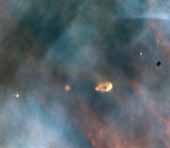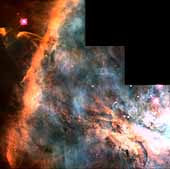
NASA announced today that a Rice University astronomer using the Hubble Space Telescope has uncovered the strongest evidence yet that the process which may form planets is common in the Milky Way galaxy, of which Earth is a part, and the universe beyond.

|
| Orion Nebula Mosaic. [more] |
O'Dell and a colleague, Zheng Wen, formerly of Rice and now at the University of Kentucky, surveyed 110 stars and found disks around 56 of them. Because it is easier to detect the star than the disk, it is likely that far more stars are being orbited by protoplanetary material, O'Dell said.
O'Dell first discovered these disks, which he dubbed "proplyds," in Hubble Space Telescope images taken in 1992. However, the new images bolster his theory by distinguishing clearly that the objects are indeed pancake-shaped disks of dust, not shells of dust as some astronomers have maintained. HST clearly resolves a young star at the center of each disk. O'Dell has also been able to measure at least a portion of the mass of a dust disk and found that the disk contains enough material to make an earth-like planet.
The theory that the Earth and other planets of the solar system were formed out of just such a disk some 4.5 billion years ago by the coalescing of matter caused by gravitational attraction is widely accepted. O'Dell said the disks in the Orion Nebula presumably contain the same materials that constitute the planets of Earth's solar system -- carbon, silicates, and other base constituents.
The only confirmed planetary system to date, consists of three earth-sized bodies orbiting a neutron star 1,000 light-years away. Since the neutron star is the burned-out remnant from a stellar explosion, these planets might have formed at the end of the star's life, and so, are not a good indicator of the abundance of planetary systems like our own.
O'Dell's findings of an abundance of protoplanetary disks in a cluster of young stars reinforces the assumption that planetary systems are common in the universe.
And because planets are necessary for life, as it is known on Earth, to become established and flourish, the likelihood that planets are common in the universe raises the likelihood of the existence of life beyond Earth.
The only place where life is known to exist is Earth. Finding life, or fossils of life, elsewhere in our solar system -- the major object of the exploration of Mars -- would be the first evidence of life beyond Earth. For life to arise independently on two planets in the same solar system would mean that life likely is not accidental and is abundant in the universe.
The Hubble images clearly distinguish the central star from the disk and show that stars in Orion that are the mass of our Sun and lower are likely to possess disks. Stars hotter than our Sun might destroy the dusty disks before they can agglomerate into planets, according to O'Dell.
Hubble can see the disks because they are illuminated by the hottest stars in the Orion Nebula, and some of them are seen in silhouette against the bright nebula. However, some of these proplyds are bright enough to have been seen previously by ground-based optical and radio telescopes as stars. Their true nature was not recognized until the Hubble observations.
One striking HST image shows a dark elliptical disk silhouetted against the bright background of the Orion nebula. "This object represents the most direct evidence uncovered to date for protoplanetary disks," says O'Dell.
Hubble's resolution has allowed O'Dell to determine accurately the mass of the outer rim of the disk. It turns out to be at least several times the mass of our Earth. The entire disk is 53 billion miles across, or 7.5 times the diameter of our solar system. The central, reddish star is about one fifth the mass of our Sun.
The disks identified in the Hubble survey are a missing link in the understanding of how planets like those in our planetary system form. Their abundance in a young star cluster shows that the basic material of planets exists around a large fraction of stars. This reinforces the probability that many stars have planetary systems.
Because the Orion star cluster is less than a million years of age, there has not been enough time for planets to agglomerate from the dust within the disks. Many of the stars are still contracting towards the mature status that they will then retain for billions of years. The most massive stars in the cluster have already reached their adult stage of maximum hydrogen fuel burning and their surfaces have become so hot that their radiation heats up the gas left over after star formation. This is visible to observers with binoculars as the Orion nebula, which is in the middle of the region known as the sword of Orion.
Hubble Space Telescope's detailed images confirm more than a century of speculation, conjecture, and theory about the genesis of a solar system.
According to current theories, the dust contained within the disks eventually agglomerates to make planets. Hubble's images provide direct evidence that dust surrounding a newborn star has too much spin to be drawn into the collapsing star. Instead, the material spreads out into a broad, flattened disk.
Before the Hubble discovery, remnant dust disks had been confirmed around only four stars: Beta Pictoris, Alpha Lyrae, Alpha Piscis Austrini, and Epsilon Eridani. They are a fraction of the mass of the proplyds in Orion, and might be leftover material from the planet formation process. Less direct detections of circumstellar material around stars in nearby star forming regions have been made by radio and infrared telescopes.
Unlike these previous observations, Hubble has observed newly formed stars less than a million years old which are still contracting out of primordial gas.
Planets are considered a fundamental prerequisite for the existence of life as we know it. A planet provides a storehouse of chemicals for manufacturing the complex molecules of biology, gravitationally holds an atmosphere of gasses that are used by life, and receives heat and light from the central star to power photosynthesis and other chemical reactions required by life forms.
O'Dell's Orion results will appear in the November 20 issue of The Astrophysical Journal.
PRESS RELEASE NO.: STScI-PR94-24
CONTACT: Ray Villard, STScI
(410) 338-4514
Dr. C. Robert O'Dell
(713) 527-8101 x3633